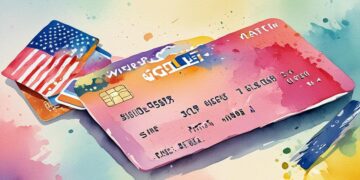The importance of an emergency fund in personal finance

Understanding the Importance of an Emergency Fund
Unexpected financial challenges can arise at any time, leaving individuals feeling anxious and unprepared. Creating an emergency fund is an essential part of managing personal finances effectively. An emergency fund acts as a safety net during times of crisis, ensuring that you can face emergencies without falling into debt. This proactive financial step not only provides peace of mind but also instills the confidence needed to navigate life’s uncertainties.
Common Situations Where an Emergency Fund is Invaluable
Emphasizing the importance of having an emergency fund, let’s look at some everyday scenarios where it can truly be a lifesaver:
- Job Loss: Losing a job can be a significant financial setback. According to a report by the U.S. Bureau of Labor Statistics, the average duration of unemployment can last several months. An emergency fund can cover your essential expenses like rent, groceries, and utilities while you look for new employment. For instance, if your monthly expenses are $3,000, having three to six months’ worth of savings set aside—between $9,000 and $18,000—can help you stay afloat during this tough time.
- Medical Emergencies: Medical bills can be overwhelming, especially if they arise unexpectedly. A report from the Kaiser Family Foundation found that nearly one in four Americans delayed receiving medical care due to costs. If you face a sudden health crisis or an accident, having funds set aside can help you manage these expenses without further stress. For example, a single visit to the emergency room can cost thousands of dollars, and having an emergency fund ensures you can pay immediately without relying on credit.
- Major Repairs: Owning a car or a home comes with unexpected repair costs. For instance, if your car breaks down or your roof springs a leak, these repairs can quickly escalate into thousands of dollars. Having an emergency fund allows you to tackle these costs without financing them through high-interest loans, keeping your overall financial picture healthy. Instead of incurring debt, you can use your savings to address these pressing issues and prevent them from impacting your budget.
In addition to these specific situations, an emergency fund helps you avoid using credit cards or loans during times of need, which can protect your long-term financial health and keep you from spiraling into debt. Credit card debt often carries high interest rates, which can make a financial crisis even more challenging to navigate.
Ultimately, establishing an emergency fund is not merely a luxury—it’s a vital component of financial stability. It equips you to deal with life’s uncertainties with confidence and keeps you on the path toward achieving your long-term financial goals. Start setting aside a small amount each month, and over time, you will build a robust financial cushion that can serve you well in times of need.
Building a Strong Foundation: How to Start Your Emergency Fund
Establishing an emergency fund may seem daunting, but it is a manageable process that can significantly improve your financial health. To start, it’s important to determine how much money you should have saved. Financial experts generally recommend setting aside between three to six months’ worth of living expenses. This amount can vary based on individual circumstances, such as the stability of your job or the number of dependents you have, but having this cushion allows you to address unforeseen costs effectively.
To create an emergency fund, consider following these key steps:
- Assess Your Monthly Expenses: Begin by evaluating your essential monthly expenses, including rent or mortgage payments, groceries, utilities, and transportation costs. Start by making a list of your necessary expenses and their amounts. For instance, if your total monthly expenses are $2,500, aim to save between $7,500 and $15,000 to cover three to six months’ worth of expenses. This foundational step will provide a realistic and clear goal for your emergency fund.
- Create a Savings Plan: Choose a target amount for your emergency fund and develop a savings strategy. If your goal is to save $10,000, you can break it down into more manageable monthly increments. By allocating $200 each month, you could accumulate $2,400 within a year, getting you closer to your target. Consider using a budgeting app or spreadsheet to track your progress, which can serve as motivation as you see your savings grow.
- Utilize a Separate Savings Account: Keep your emergency fund in a dedicated savings account separate from your regular checking and savings accounts. This separation simplifies budgeting and reduces the temptation to dip into your emergency savings for non-emergency expenses. Opt for a high-yield savings account to earn interest on your savings while keeping the funds easily accessible. Many online banks offer higher interest rates than traditional brick-and-mortar banks, which can accelerate your savings growth.
- Automate Your Savings: Automate your contributions by setting up direct deposits or automatic transfers. By making savings a priority and scheduling your monthly transfers, you can build your emergency fund more consistently without having to think about it each month. For instance, if your paycheck allows it, you might schedule an automatic transfer of $100 to your emergency fund right after payday so that it’s “out of sight, out of mind.”
As your emergency fund grows, it’s important to reassess your goals periodically. Life is full of changes that can affect your financial situation, such as starting a new job, moving to a different city, or welcoming a new family member. Whenever your circumstances change, re-evaluate your monthly expenses again and adjust your savings goals accordingly to ensure you’re adequately prepared for any financial surprises that might arise.
Having an emergency fund is akin to having an insurance policy for your finances; it’s there to protect you when life surprises you with unexpected expenses, like medical bills, car repairs, or job loss. This financial cushion provides not only stability but also peace of mind, enabling you to focus on your long-term financial goals and aspirations without the constant worry of unexpected financial setbacks. Remember, starting small is still progress, and every dollar saved brings you one step closer to achieving your emergency fund goal.
The Benefits of Having an Emergency Fund
While establishing an emergency fund is a solid financial strategy, understanding the benefits it provides can reinforce your motivation to create and maintain one. An emergency fund serves as a financial safety net that can have far-reaching effects on your overall financial well-being.
Protection Against Financial Emergencies: The most obvious benefit of having an emergency fund is being prepared for unforeseen expenses. Whether it’s an unexpected medical bill, a home repair, or job loss, an emergency fund allows you to handle these situations without going into debt. For example, if your car breaks down and requires a $1,200 repair, you can simply pay for it out of your emergency fund instead of relying on high-interest credit cards or loans. By having this cushion, you’re not only protecting yourself from immediate financial strain but also from the potential long-term repercussions of accumulating debt.
Reduced Stress and Improved Mental Health: Financial burdens often lead to significant stress and anxiety. With a well-funded emergency fund, you can alleviate some of that worry. Knowing that you have a financial buffer allows you to approach life’s challenges from a place of security rather than fear. Studies have shown that individuals with adequate emergency savings report higher levels of satisfaction and reduced anxiety surrounding financial matters. By having that safety net, you can focus on your daily responsibilities and long-term goals without the nagging fear of unexpected expenses derailing your progress.
Greater Financial Flexibility: An emergency fund gives you the freedom to make choices that align with your values and goals. For instance, if you receive a job offer with a lower salary but more satisfaction and career growth opportunities than your current job, having an emergency fund gives you the financial flexibility to take that leap without the immediate pressure of financial insecurity. Similarly, it can enable you to consider meaningful personal choices: from traveling for a spiritual retreat to moving to a new city for better opportunities. With an emergency fund backing your decisions, you can confidently approach changes and opportunities that come your way.
Building Financial Discipline: Creating and maintaining an emergency fund also promotes healthy financial habits. The process of budgeting, monitoring expenses, and prioritizing savings teaches you to manage your financial resources wisely. These habits can lead to a domino effect of positive financial behaviors. Once you master the discipline of saving for emergencies, you may find yourself more motivated to contribute to retirement accounts, invest in your future, or save for larger purchases, ultimately improving your financial literacy and advanced planning skills.
Enhanced Creditworthiness: Finally, maintaining an emergency fund can improve your creditworthiness. When you’re prepared for unplanned expenses, you’re less likely to rely on credit cards or loans during financial turbulence. This proactive approach can lead to more consistently on-time payments and better debt management, which contributes positively to your credit score. A good credit score not only increases your chances of being approved for loans at favorable interest rates but also provides you with financial options that can further enhance your economic stability.
In summary, the importance of an emergency fund extends far beyond mere financial preparation; it encompasses mental well-being, personal freedom, financial discipline, and creditworthiness. By building a sustainable savings plan, you can invest in a future that is not just secure but also aligned with your aspirations and dreams.
Conclusion
In conclusion, establishing an emergency fund is an essential pillar of sound personal finance management. By setting aside money for unforeseen circumstances, you can create a solid safety net that protects you from potential financial disasters. This not only safeguards your financial health but also contributes significantly to your overall mental well-being. When you know you have resources available to handle unexpected bills, job losses, or emergencies, you can approach life with greater confidence.
An emergency fund fosters financial independence and freedom, allowing you to make choices that align with your personal goals rather than merely reacting to crises. Whether it’s accepting a new job opportunity, pursuing educational goals, or taking a long-overdue vacation, having a reserve empowers you to take calculated risks. Moreover, the discipline of saving and budgeting for such a fund cultivates valuable financial habits that can permeate your entire financial landscape, enhancing your ability to save for retirement or invest in other opportunities.
Lastly, the impact of an emergency fund extends to your creditworthiness. By being less reliant on credit during tough times, you are poised to maintain a better credit score, which translates into better borrowing options for the future. Ultimately, setting up an emergency fund is not merely a precaution; it’s an investment in your peace of mind and financial freedom. As you consider your financial strategies, make sure that building an emergency fund is a priority you embrace—you’ll thank yourself when life throws those unexpected challenges your way.

Linda Carter is a writer and financial expert specializing in personal finance and investments. With extensive experience helping individuals achieve financial stability and make informed decisions, Linda shares her knowledge on the Territorio Deficiente platform. Her goal is to provide readers with practical advice and strategies for financial success and smart investments.






